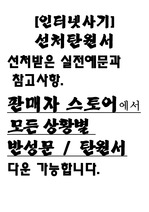Leadership Success and Failure
*아*
다운로드
장바구니
소개글
리더쉽에 대한 에세이입니다목차
IntroductionWhat is leadership?
Traits of Leadership
Characteristics of leadership
Transformational leadership
conclusion
본문내용
Humanity has been kept focus on leadership for a long history and the leadership lecture is regarded to be a basic course at the business classes. “Leadership” can be defined organizationally and narrowly as the ability of an individual to influence and motivate others to contribute toward the effectiveness and success of the organizations of which they are members. Organizationally, leadership directly impacts the most important values of the company including the effectiveness of costs, revenue, market value, share price, and so on. Leadership is the ability of an individual to set rules for others and lead from the front.참고 자료
Adair, J. Action Centered Leadership, Grower, 1979Burns, J. M. Leadership, Harper & Row, 1978
C. A. Bartlett, A. N. McLean, GE’s Talent Machine : The Making of a CEO, 2006.
Dansey-Smith, F. Why soft people skills are the key to leadership development, Strategic HR Review, 3(3):28-31, 2004.
Drucker, P. F. The Practice of Management, Heinemann Professional, 1989
Hernez-Broom, G. and Hughes, R. L. Leadership development: past, present and future, Human Resource Planning, 27(1): 24-32, 2004.
Kotter, J. The Leadership Factor. New York: Free Press, 1988.
Kotter, J. A Force for change: How leadership differs from management, New York ; London : Free Press, 1990.
McCall, M. W. Leadership development through experience, Academy of Management executive, 18(3): 127-30, 2004.
Manz, Charles and Sims, Harry (1987) ‘Leading Workers to Lead Themselves: The External Leadership of Self-Managing Work Teams’, Administrative Science Quarterly, No32.
Mullins, Laurie J., Management and Organizational Behaviour. 8th edition. Harlow: Financial Times Prentice Hall, 2007.
Robbins, S.P., Organizational Behaviour. 11th edition. Upper Saddle River, N J: Prentice Hall International, 2005.
Ridley, M. (2003). Nature Via Nurture New York: Harper Collins.
Schriesheim, Chester A. The Great High Cinsideration- High Initiating Structure Leadership Myth: Evidence on its Generalizability. The Journal of Social Psychology, April 1982, 116, pp. 221-228.
Tannenbaum, R & Schmidt, W. H. ‘How to choose a Leadership Pattern’, Harvard Business Review, May-June, 1973, pp. 162-75, 178-80
Tim Hannagan (2002) Management; Concepts and Practices, Edinburgh Gate: Pitman





























